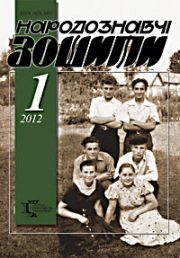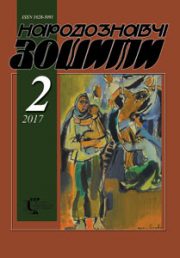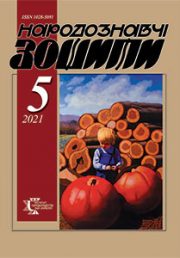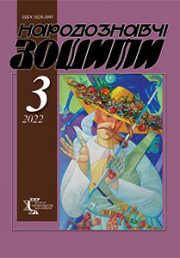The Ethnology Notebooks, 2018, № 5 (143), 1161—1167
UDК 7.74.745.51
DOI https://doi.org/10.15407/nz2018.05.1161
Received 03.10.2018
ORCID ID: https://orcid.org/0000-0003-0815-6096
Molyn’ Valentyna, Candidate of Sciences in Art Studies,
Associate Professor, manager of
department of fine art and academic disciplines member
of the National union of artists of Ukraine.
Kosiv’s institute of the applied and decorative art
Lviv national academy of arts.
Street of Mitskevych, 2, 78600, Ivano-Frankivsk area, Kosiv, Ukraine
Contacts: +380682265428, valentynamolyn@gmail.com
Abstrakt. Article is devoted to works of the famous master of art wood in Hutsulzhyna Shkriblyaka Yuri (1822—1884) and his sons — Vasil, Nicholas and Fedora. Grate active carvers dynasty Shkriblyaka in exhibitions that took place in Galychyna, particularly in Vienna (1873), Lviv (1894, 1905), Stanislav (1879), Kolomya (1880, 1912), Ternopil (1887).
Keywords: Yuri Shkribliak, dynasty, carving, exhibitions, folk art, Hutsulzhyna, Galychyna.
REFERENCES
Budzan, A.F. (1960). Rizba po derevu v zakhidnykh oblastiakh Ukrainy. Kyiv: Vydavnytstvo Akademii nauk Ukrainskoi RSR [in Ukrainian].
Budzan, A.F. (1960). Rizba po derevu. Roboty rizbiariv Yury, Vasylia ta Mykoly Shkribliakiv. Kyiv: Vyd. Akademii nauk Ukrainskoi RSR [in Ukrainian].
Vystava domashnoho promyslu v Kolomyi pid protektoratom yikh ts. k. Vysokosty Arkhykniazia Karolia Frantsa Yosyfa i Arkhikniahyni Zyty v dniakh 21–30 veresnia 1912 roku: Kataloh. (1912). Kolomyia: Nakl. vystavkovoho komitetu z druk. A.V.Kysylevskoho i S-ky [in Ukrainian].
Vustavka hospodarsko-promyslova v Kolomui. Spravozdane Petra Chornoho. (1881). Stanyslavovъ [in Ukrainian].
Danyliuk, A.H. (1984). Ukrainska narodna arkhitektura na kraievii vystavtsi u Lvovi 1894 roku. Narodna tvorchist ta etnohrafiia, 1, 50–52 [in Ukrainian].
Iz vustavky Stanyslavovskoi. Nashe rezbiarstvo (1879). In Hospodar y promyshlennyk, 41–45 (Vol. 1, part 3). Stanyslavov [in Ukrainian].
Kis-Fedoruk, O. (2000). Iz sposterezhen nad typolohiieiu hutsulskoi ploskorizby. (Na materiali tvorchosti Shkribliakiv). Narodna tvorchist ta etnohrafiia, 2—3, 103—106 [in Ukrainian].
Krechkovskyi, L. (1994). Shkola derevnoho promyslu v Kolomyi. Zhyvotoky: Statti, ese, rozvidky (pp. 5–9). Kolomyia: Narodnyi dim [in Ukrainian].
Levytskyi, V. (1904). Vystava hutsulskykh vyrobiv v Kosovi. Dilo,135 [in Ukrainian].
Lukiianovych, D. (1912). Vystava domashnoho promyslu v Kolomyi. Nedilia, 38–40. Lviv [in Ukrainian].
Mozdyr, M.I. (1987). Rizbiarstvo. In Hoshko, Yu. (Ed.), Hutsulshchyna. Istoryko-etnohrafichne doslidzhennia (pp. 388—405). Kyiv: Naukova dumka [in Ukrainian].
Molyn, V. (2002). Klasyk hutsulskoi rizby (Do 180-richchia vid dnia narodzhennia Yuriia Shkribliaka). Narodne mystetstvo, 1—2, 23—25 [in Ukrainian].
Molyn, V. (2008). Maistry narodnoho dekoratyvnoho mystetstva Stanislavshchyny u «vystavkovomu rusi» Halychyny. In Ukrainska akademiia mystetstva. Doslidnytski ta naukovo-metodychni pratsi, 15, 366–377. Kyiv: Natsionalna akademiia obrazotvorchoho mystetstva i arkhitektury [in Ukrainian].
Persha ukrainska khliborobska vystavka v Stryiu (1909). In Hospodar i promyslovets, 20. Stryi [in Ukrainian].
Zakharchuk-Chuhai, R.V. (1979). Rodyna Shkribliakiv. Albom. Kyiv: Mystetstvo [in Ukrainian].
Selivachov, M.R. (2002). Yurii Shkribliak i yoho vnesok u rozvytok ukrainskoho obrazotvorchoho mystetstva. Narodna tvorchist ta etnohrafiia, 5—6, 59–65 [in Ukrainian].
Stankevych, M. (2002). Ukrainske khudozhnie derevo XX—XXI st. Lviv [in Ukrainian].
Trush, I. (1905). Vystava ukrainskykh artystiv. Artystychnyi visnyk, 2–3, 24–28; 4, 43; 5, 58–62 [in Ukrainian].
Shukhevych, V.O. (1997). Hutsulshchyna. Persha i druha chastyny. Repryntne vidtvorennia vydannia 1899 roku. Verkhovyna [in Ukrainian].
Wystawa etnograficzna Pokucia w Kolomyi przez Marcelego Turkawzkiego. (1880). Krakow: Czcionkami drukarni «Czacu» [in Polish].







